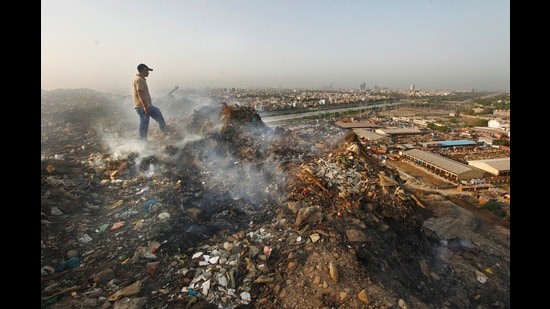Description

Disclaimer: Copyright infringement not intended.
Context
- The biomining project initiated by the Municipal Corporation of Delhi (MCD) aimed to clear the oversaturated landfill sites at Ghazipur and Bhalswa.
- Despite efforts, the project is likely to miss the latest deadline of 2024 due to various challenges.
Details
- Biomining involves separating various components of legacy waste such as plastic, paper, cloth, sand, and bricks using trommel machines.
- MCD launched the biomining project in July 2019 following the National Green Tribunal's directive to clear legacy waste dumps within a specified timeframe.
- The ongoing dumping of fresh waste and adverse weather conditions, especially during the monsoons, have slowed down the biomining process.
- Disposal issues related to inert material and plastic derived from the biomining process also contributed to delays.
- Multiple revisions and extensions of deadlines were necessary due to these challenges.
Biomining
- Biomining, also known as phytomining, is a method of extracting metals from ores and solid materials using prokaryotes, fungi, or plants.
- Microorganisms such as bacteria and archaea secrete organic compounds that chelate metals from the environment, making them accessible for extraction.
History
- Biomining dates back to the discovery in 1950 that Acidithiobacillus ferrooxidans thrives in iron-, copper-, and magnesium-rich environments.
- Subsequent research revealed the potential of microorganisms, including fungi, in leaching metals from their environment.
- Biomining has evolved into an environmentally friendly alternative to traditional mining, with applications in extracting iron, copper, zinc, gold, uranium, and thorium.
Mechanisms of Biomining
- Biomining primarily involves biooxidation and bioleaching processes.
- Biooxidation utilizes iron- and sulfur-oxidizing microorganisms to release occluded metals from mineral sulfides.
- Bioleaching involves the use of organic acids produced by microbial metabolism to dissolve metal ions from ores.

Types of Biomining
- There are two primary types of biomining: heap leaching and stirred tank reactor (STR) bioleaching.
- Heap leaching involves piling ores in heaps and irrigating them with microbial solutions, while STR bioleaching uses bioreactors for controlled microbial activity.
- Biomining can target various metals, including copper, gold, uranium, and rare earth elements, depending on the microbial consortium and ore composition.
Industrial Applications
- Biomining processes target various metals, including copper, gold, uranium, and rare earth elements.
- Large-scale biomining operations utilize chemostats of microbes to leach metals from ores, offering a sustainable and eco-friendly alternative to traditional mining methods.
Microbial Processes in Biomining
- Microorganisms such as Acidithiobacillus ferrooxidans facilitate the leaching of copper from mine tailings.
- Thermophilic archaea like Sulfolobus metallicus and Metallosphaera sedula are efficient in extracting metals from sulfide ores, particularly copper.
Environmental and Economic Benefits
- Biomining reduces energy consumption, water usage, and carbon emissions compared to traditional mining methods.
- It permits extraction from low-grade ores, contributing to resource recovery and waste remediation.
- Biomining has become economically viable, with approximately 25% of all copper mined worldwide now obtained from leaching processes.
About Waste Treatment
- Waste treatment encompasses various processes aimed at managing and reducing the environmental impact of waste materials.
- It involves the conversion, neutralization, or disposal of waste to minimize pollution and promote environmental sustainability.
Types of Waste
- Solid Waste: Includes household garbage, industrial waste, and municipal solid waste.
- Liquid Waste: Consists of wastewater from households, industries, and agriculture.
- Gaseous Waste: Includes emissions from industrial processes, vehicles, and combustion.
Waste Treatment Processes
A)Physical Processes
- Screening and Sorting: Separates waste materials based on size, density, and composition.
- Shredding and Grinding: Breaks down large solid waste into smaller particles for further processing.
- Compaction: Reduces the volume of waste through compression, making it easier to handle and transport.
- Incineration: Thermal treatment of waste at high temperatures to convert it into ash, gases, and heat energy.
B) Chemical Processes
- Neutralization: Adjusts the pH of acidic or alkaline waste to make it less harmful.
- Oxidation: Converts organic waste into simpler, less harmful compounds through chemical reactions.
- Precipitation: Forms insoluble precipitates by adding chemicals to wastewater, facilitating the removal of contaminants.
C) Biological Processes
- Composting: Decomposes organic waste using microorganisms to produce nutrient-rich compost for soil enrichment.
- Anaerobic Digestion: Breaks down organic waste in the absence of oxygen, producing biogas (methane) and organic fertilizer.
- Bioremediation: Uses microorganisms to degrade or detoxify hazardous substances in soil, water, or air.
D) Advanced Treatment Technologies
- Membrane Filtration: Removes suspended solids, bacteria, and contaminants from wastewater using membrane filters.
- Activated Carbon Adsorption: Absorbs organic pollutants and odors from liquid and gaseous waste streams.
- Reverse Osmosis: Purifies water by removing dissolved salts and contaminants through a semipermeable membrane.
- Ultraviolet (UV) Disinfection: Inactivates pathogens and microorganisms in water and wastewater using UV light

Waste Disposal Methods
- Landfilling: Burying waste in designated landfills with protective liners to prevent groundwater contamination.
- Incineration: Burning waste at high temperatures to reduce its volume and generate energy.
- Recycling: Collecting and processing waste materials to produce new products or raw materials.
- Hazardous Waste Treatment: Specialized processes for handling and disposing of hazardous materials, such as chemical incineration and detoxification.
Environmental Impact and Sustainability
- Effective waste treatment reduces pollution, conserves resources, and protects ecosystems and human health.
- Sustainable waste management practices promote the reuse, recycling, and recovery of valuable materials from waste streams.
- Public awareness, government regulations, and technological innovations play key roles in promoting environmentally responsible waste treatment practices.
|
PRACTICE QUESTION
Q. By employing a combination of physical, chemical, and biological techniques, waste treatment facilities can minimize pollution and maximize resource recovery. Illustrate with examples. (250 Words)
|














